Table of Contents
Improve your Google Ranking using responsive webdesign
Responsive web design (RWD), simply put, are techniques adopted during web application creation to enable the reader with an easy reading and navigation experience across multiple devices such as desktop computer monitors to mobile phones. A RWD compliant web-site tends to adapt the layout of the viewing environment facilitating minimum of page resizing and scrolling.
The following techniques are commonly used to accomplish RWD :
1. Page elements are sized during creation in relative units like percentages rather than fixed units such as points or pixels.
2. Images are scoped in the web-pages as relative units (and not absolute ones).
3. Usage of different CSS style rules based on specifics of the device the site is displayed on – most commonly the width of the browser.
Responsive designing is a key
Responsive designing is a key requirement in web design with more target devices like the iPad mini finding their way in the market. Web-site owners today face the challenge of have a separate web-site designed per target device or making the current site responsive. Targeting specific devices is undoubtedly a costly affair adding up with maintaining the version going ahead.
Google, the big daddy of search engines recommends responsive web design as a preferred design pattern:
“Google recommends webmasters follow the industry best practice of using responsive web design, namely serving the same HTML for all devices and using only CSS media queries to decide the rendering on each device.”
Google’s recent announcement
A recent announcement by Google stated they will be making changes to its rankings of smartphone search results. When a user ends up on a site which is not catered to run well on smartphones, the search experience could prove quite frustrating. A common outcome would be the user would cease the search effort or would spend more time than necessary to find the information he was looking for.
A common example of a non-adaptive site involves faulty redirects. We often observe pages on the desktop site redirect smartphone users to the home page of the mobile site. This would cause the phone user more time in reaching the destination page. A responsive design on the other hand, does not require queries to redirect users to a different URL. A critical aspect worth a big score in the ranking – the load time of the webpage – is thus achieved. Agreeably, page loading time is one of the most important aspects that Google uses while ranking a page, because of the impact of loading time on the user experience – and what is good for user experience is good for rankings.
Quality Content as good sign
Another common non-compliance is duplicate content across both the application variants. Web-masters who create hand-held versions of their web-sites usually borrow content from their main web-site. This dents credibility of the mobile site from the search engines perspective. On a similar context, an interesting point to note is the ability of RWD to help tackle a high bounce rate. Even if a site scores high in search results, if it doesn’t work effectively for mobile and tablet users, these websites may suffer from high bounce rate. Google will interpret this as a sign that it is not providing relevant or quality content to the users. This would likely lead to a drop in rankings for the site. A RWD compliant web-site tackles this issue by presenting the same content found on the desktop site to other devices
Validate other Errors
Additionally, Google considers a down-side in ranking if your web-site is prone to ‘configuration errors’ like non-functional media (for e.g. unplayable videos), irrelevant cross linking to name a few. Unplayable media may occur due to licensing issues or missing capabilities / dependencies that the smartphone do not support. HTML5 standard tags are recommended to include videos in web-site instead of content in formats, such as Flash, that do not support all mobile devices. If your smartphone friendly URL has links to the desktop-optimized version and likewise a link from the desktop page to the smartphone page, it may not favor the Google algorithm. Therefore, you should make sure that the links point to the correct equivalent page.
Further-more, a simple and a user friendly web-design is equally important to gain maximum user attention and time, hence consider having your web application conceived by professional and experienced web designers. All in all, user experience is a key attribute in Google algorithm, hence highly responsive sites will see a rise in rankings.
FAQ
How long does it take to create a responsive website?
To get started, a typical website will take 14 weeks from minimum from inception to the delivery stage. It could take much longer depending on your requirements. Discuss with your website development team to get an idea about the delivery date. Actively research the market and the best service provider to get it done professionally. Website development is one of the crucial aspects of your business on which you shouldn’t compromise. Ensure that you get regular updates from your development team to make sure everything is executed as per the schedule. There are chances that conflicts might arise which may compromise the overall development process, you should be prepared to tackle the situation and get things done in a smooth manner.
What are breadcrumbs?
Breadcrumbs are nothing but a secondary navigation system that can be used to learn about the user’s location on a particular website. Visitors can get a better idea about the webpage if they have an overview of the hierarchy on the website. They serve as an effective visual aid that represents the location of a user within the website. It is not a complex mechanism on websites and will up only a line on your website. One of the main advantages of breadcrumbs is that they do not have any negative impact on your website in terms of content overload. If you have a large number of web pages piled up on your site, you must incorporate breadcrumbs into your site.
What are accelerated mobile pages?
Accelerated Mobile Pages is an open-source project that is designed to optimize faster mobile pages. To break it down into simpler terms, it is making a page loading faster that is already optimized to be mobile-friendly. You have to use a streamlined version of CSS if you are opting for accelerated mobile pages. The website must be validated properly on a regular basis to ensure that they work properly. If you are looking to offer a better user experience, incorporate custom fonts into it and declare the proper height & weight of the page to avoid quirky-loading images. Accelerated mobile pages can significantly reduce the overall bounce rate on your website and improve conversion rates for your business.
Why is website development important?
How good your website is has a lot to do with the business you generate at the end of the day. Here is why website development is important.
- The first impression of your business is the website. If your website is outdated, the impression of the business left behind is definitely not what you’d want.
- By looking at how well the website is developed, the customers get a fair idea of how they would be treated by the business. If the website is not worked upon well, they tend to believe that the business won’t take efforts in catering to the requirements of the customers as well.
- A well-designed website enables the audience to build trust with the business.
- A poorly designed website has an adverse impact on Search Engine Optimization (SEO).
What makes a good website in 2022?
In order to make it into the list of good websites, there are a couple of things that one needs to take note of.
- A good website doesn’t take much time to load.
- A website that is trustworthy – both in terms of content as well as technicalities is the most sought after.
- The website should be free of bugs.
- Make sure that your website caters to a specific goal/objective.
- For a website to reach out to the maximum, it is important to understand the target audience in-depth, right from what they need to what other websites do they use.
- Making use of the right words, font and style always help.
What are the types of E-Commerce?
There are 4 main types of E-Commerce –
- B2B (Business to Business) – Here, a business sells its products or services to another business. In a majority of cases, the business that is at the buying end further sells the products or services to the consumers.
- B2C (Business to consumer) – This is the most common of all the types wherein a business sells its products or services directly to the consumer.
- C2B (Consumer to Business) – This is where consumers sell products or services to the companies.
- C2C (Consumer to Consumer) – This is where consumers exchange goods and services among themselves and make money by charging transaction or listing fees.
Does dark mode website design really help your business?
Dark Mode website design has been adopted by some of the biggest technology giants out there. Needless to say dark mode is projected as a beneficial aid to the customers who use their tech rather than as a beneficial feature to the service provider. Dark Mode is easy on the user’s eyes, especially in low light or at night. The dark design stretches their battery consumption enabling them to spend longer hours on their phones without having to charge the phone. The design is also aesthetic focussing more on text over a dark background that pops out. The search engine doesn’t have a preference for dark mode over light, but the higher number of users automatically signals the search engine to improve the ranking of the site.
What are the benefits of web designs services?
Web design services help you give a great first impression to your customers. Professionally designed webpages get good customer retention rates. Good web design goes hand in hand with SEO strategies. Search Engines rank sites with good design higher in the results pages. Web design services automatically optimise the website to attract high volume of visitors. This traffic also results in increased conversions. A professionally designed website gives the impression that your site and business are reputed with good credibility. It can subtly boost your conversions. An expert web design service will set you up with a site that projects the personality of your brand perfectly. It sets the right tone of communication that nudges the customers towards the call to action. It enhances the customer experience earning their loyalty.
What are the newest trends in website design?
Website design has come a long way from the basic blue and white theme with black text to colourful, interactive spaces that have become even primary source of income for businesses. Here are the latest trends in web design that will keep you on top of the industry. Parallax Animation: The foreground is designed to move faster than the background creating a 3D visual effect. Neumorphism: Digital embossing with soft backgrounds with overlay elements that have a shadow to lift them off the screen. Dark Mode: Like mobile apps websites too are turning to dark mode to give viewers a comfortable experience. Pastel Colours: Businesses are going with pastel colour themes to give a visually soothing customer experience. Scrolling transformations: The elements on the screen are designed to move and transform with scrolling creating a video like effect.
How can I increase the traffic on my website?
There are several ways to increase and divert traffic to your website. Listed are a few that you might be interested in.
- Invest in some paid advertising that will guarantee you results.
- Open Social Media accounts and post attractive content regularly.
- Use attractive titles that make browsers want to open the link.
- Review and up your on page SEO game.
- Target long tail keywords with colloquialisms for each customer location.
- Indulge in some guest blogging that will build external links
- Strengthen internal linking to subtly encourage more customer interaction.
- Make your site responsive to be accessible on all devices.
- Improve site loading speed to reduce abandonments.
- If you are an E-Commerce site, post clear and attractive product images.
What is the best way to build your website?
Congratulations on your decision to make a website for your business. Follow these steps for the best way to build a successful website.
- Choose a web developer. Find a web developer with experience and knowledge of website design.
- Choose an initial web template. Select a suitable template and ask your developer to build and customise on it.
- Edit and Review the site. Insert your content, images and graphics in the website. Before launching it, test the site’s performance to work out the kinks.
- Create a domain. A domain is the unique address of your site and has to be registered with a domain provider.
- Publish your website: Now that your website is designed and done, you are ready to publish it.
What are the most important principles of web design?
By now a lot of businesses have realised the importance of good web design. However there are some important principles that need to be followed to ensure that your website turns out perfect.
- Ensure the website loads fast, as this reduces website abandonment.
- Show your intent on every page so customers landing on any page are aware of what your business does.
- Keep it simple so you don’t distract visitors from their purpose, with too many elements.
- Make the navigation as easy as possible, with any part of the website accessible in 3 clicks.
- Maintain the hierarchy in the layout. You don’t want your customers to keep scrolling back up each time they want to refer something.
- Use simple, attractive and value adding content that can convince visitors into becoming customers.
- The site must be mobile friendly for customers to access it on the go.
What is the purpose of website design?
Your website is the first impression that an online customer gets of your business. It is important to make a positive impact on your clients. The website design has the potential to convert a random visitor to a customer and boost organic sales. A great web design will keep customers loyal to your brand as they find the platform comfortable and convenient to use. It provides a good UI/UX to your clients and nurtures your leads. Better the website design, more the engagement with it, bringing in more traffic. It improves the accessibility of your website to a wider audience. It has a significant influence on the brand image and it is important that you get professionals to design your website.
What are the benefits of having a website to your business?
It has come to a point that a business is only considered successful if they have a strong online presence. This is evidently done by creating a dedicated website to the brand. The benefits of owning a website for your business are,
- A credible repository of information on your business
- 24 x 7 customer access to your business
- Boosts interaction with the brand
- It helps expand your market reach
- It improve brand awareness to a global scale
- Provides you with valuable consumer insights
- Helps you beat other competitors with online presence
- Access to all digital modes of advertising
- Makes information exchange easier
What is the difference between website design and website development?
When searching for a web developer, it is important for you as a client to know the difference between website design and website development. The difference is quite distinct but a web developer is capable of doing both if they are skilled enough. Web design is the initial ideation and planning of a website’s layout, appearance and content. Web development is the actual process of developing code for creating the site and its subsequent maintenance. Web design is about creativity, while web development is completely technical. You need to engage the services of web developers who can help you with both, as they know how to recreate your brand personality on the website.
Why every business needs SEO?
For anyone who wants to implement digital marketing for their business, Search Engine Optimisation or SEO as it is commonly known should be the first priority. It is more than the misconception of just adding keywords to your content. When done right, SEO can do the following for you.
- Send quality traffic your way.
- Boost the business reputation
- Get results with inexpensive methods
- Increases customer engagement with the site
- Help you understand your customers
- Help you beat the competition
- Continuously evaluate and boost performance of the site
Why Digital marketing is important for marketing?
Digital Marketing has become an essential part of today’s business world. It has become so competitive that traditional marketing methods are no longer as effective as before. Digital marketing can improve your conversion rate, boost traffic to the site, keep your customers engaged, helps you understand the market and customers with valuable insights, increases your reputation, and is generally cost effective. Most of your online customers are using their mobile phones to access your site. Digital marketing helps make your business more accessible to mobile users, who make up nearly 60% of the clientele. It makes the entire customer journey more interactive and memorable, bringing you loyal customers, who come just for a good user experience. Digital marketing can also be automated, freeing you from the hassle of keeping track of the campaigns.










